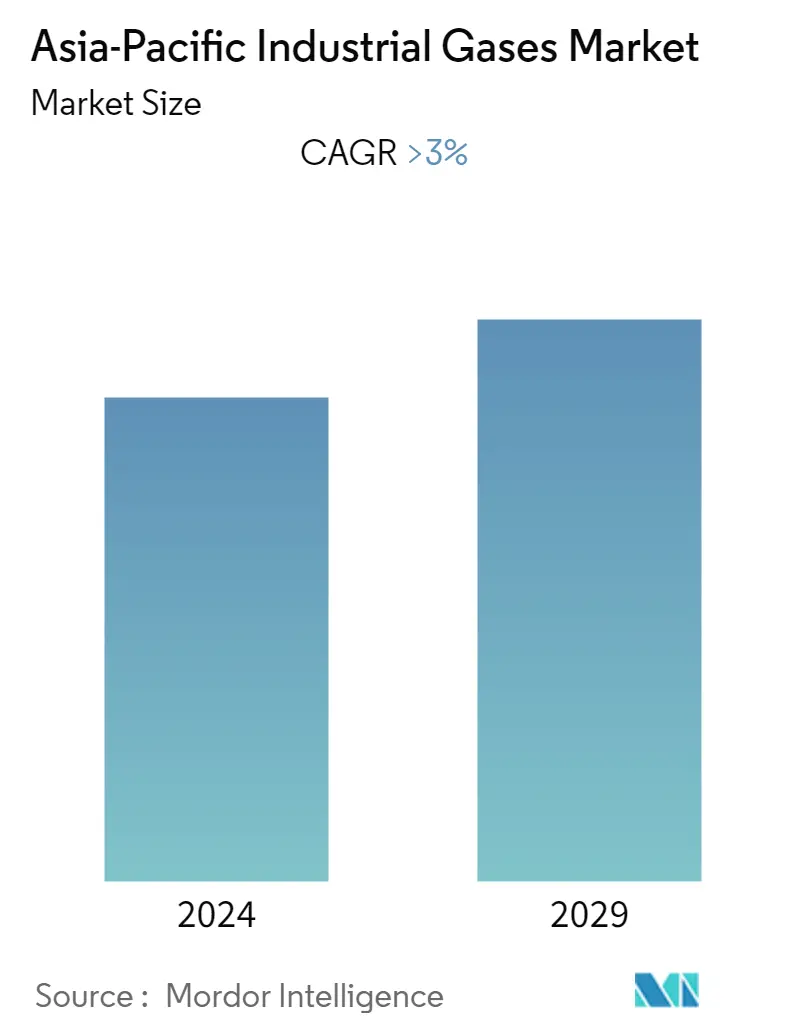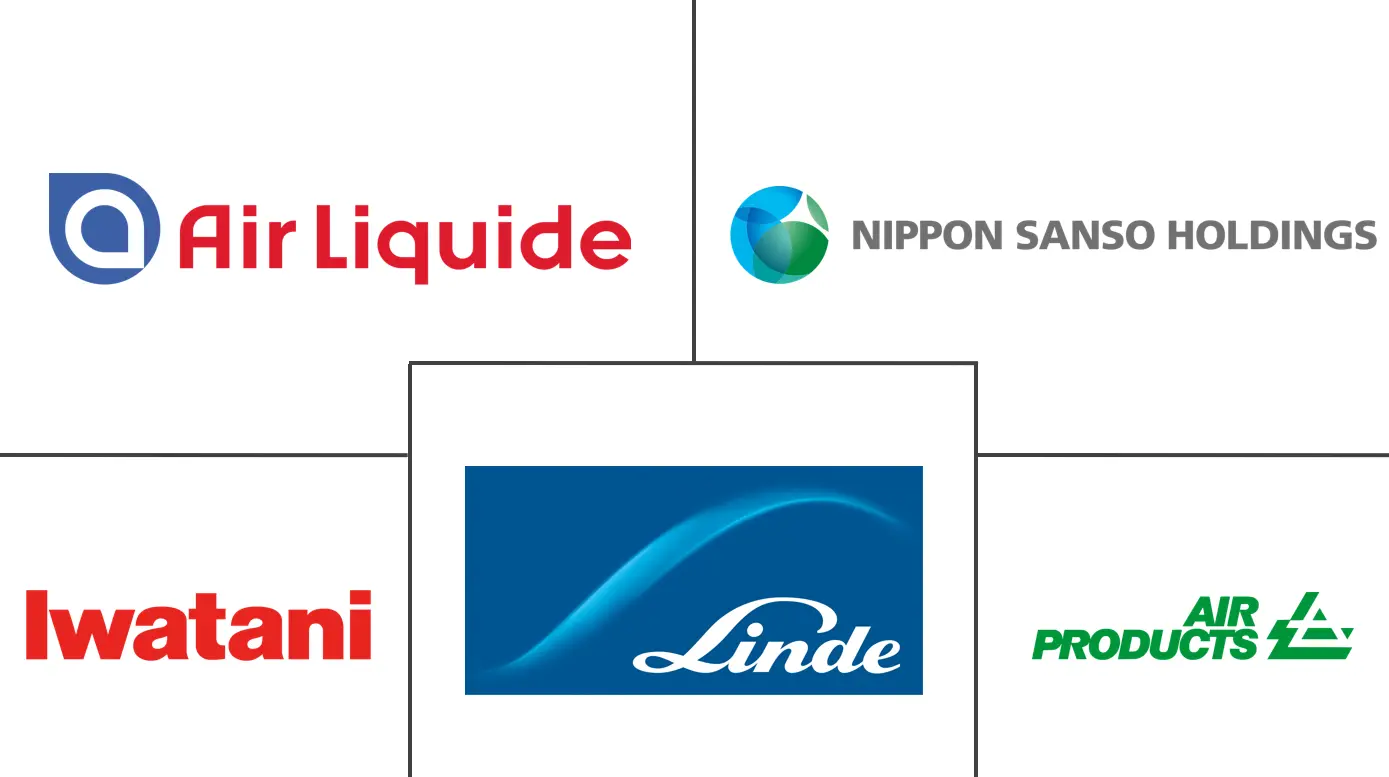Market Size of Asia-Pacific Industrial Gases Industry

| Study Period | 2019 - 2029 |
| Base Year For Estimation | 2023 |
| Forecast Data Period | 2024 - 2029 |
| Historical Data Period | 2019 - 2022 |
| CAGR | 3.00 % |
| Market Concentration | High |
Major Players
*Disclaimer: Major Players sorted in no particular order |
Need a report that reflects how COVID-19 has impacted this market and its growth?
Asia-Pacific Industrial Gases Market Analysis
The Asia-Pacific industrial gases market is estimated to reach 50.35 million tons by the end of this year. It is projected to reach 60.58 million tons in the next five years, registering a CAGR of 3.77% during the forecast period.
The COVID-19 pandemic affected several industries negatively. The lockdown in most countries in the region caused disruptions in industrial activities and freight transportation that disturbed the supply chain in nearly every end-user industry. However, the conditions started recovering in 2021, restoring the market's growth trajectory.
- Over the short term, growing demand from the frozen and stored food segment and the growing need for alternate energy sources are major factors driving the growth of the market studied.
- However, the environmental regulations and safety issues concerning industrial gases are likely to restrain the growth of the studied market.
- Nevertheless, growing demand for low-carbon gases in the coming years will likely create lucrative growth opportunities for the market in the coming years.
- China represents the largest market for industrial gases in the region and is likely to witness strong growth in demand on the back of increasing oil and gas production and refining and chemical production capacities.
Asia-Pacific Industrial Gases Industry Segmentation
Industrial gases are gases produced in relatively large quantities by gas manufacturing companies for use in various industrial manufacturing processes. These gases are sold to other enterprises and industries, including oil and gas, petrochemicals, chemicals, power, mining, steelmaking, metals, environmental protection, medicine, pharmaceuticals, biotechnology, food, water, fertilizers, nuclear power, and electronics.
The Asia-Pacific industrial gases market is segmented by product type, end-user industry, and geography. By product type, the market is segmented into nitrogen, oxygen, carbon dioxide, hydrogen, helium, argon, ammonia, methane, propane, butane, and other types (fluorine and nitrous oxide). By end-user industry, the market is segmented into chemical processing and refining, electronics, food and beverage, oil and gas, metal manufacturing and fabrication, medical and pharmaceutical, automotive and transportation, energy and power, and other end-user industries (water treatment and environmental protection). The report also covers the market size and forecasts for the Asia-Pacific industrial gases market in five countries across the Asia-Pacific region.
For each segment, the market sizing and forecasts are provided on the basis of volume (tons).
| By Product Type | |
| Nitrogen | |
| Oxygen | |
| Carbon dioxide | |
| Hydrogen | |
| Helium | |
| Argon | |
| Ammonia | |
| Methane | |
| Propane | |
| Butane | |
| Other Product Types (Fluorine and Nitrous oxide) |
| By End-user Industry | |
| Chemical Processing and Refining | |
| Electronics | |
| Food and Beverage | |
| Oil and Gas | |
| Metal Manufacturing and Fabrication | |
| Medical and Pharmaceutical | |
| Automotive and Transportation | |
| Energy and Power | |
| Other End-user Industries (Water Treatment and Environmental Protection) |
| By Geography | |
| China | |
| India | |
| Japan | |
| South Korea | |
| ASEAN Countries | |
| Rest of Asia-Pacific |
Asia-Pacific Industrial Gases Market Size Summary
The Asia-Pacific industrial gases market is experiencing a steady growth trajectory, driven by increasing demand from various sectors such as frozen and stored food, as well as the need for alternative energy sources. Despite the initial setbacks caused by the COVID-19 pandemic, which disrupted industrial activities and supply chains, the market has shown resilience and is on a path to recovery. Environmental regulations and safety concerns pose challenges to market expansion, yet the rising demand for low-carbon gases presents significant opportunities for future growth. China stands out as the largest market within the region, benefiting from its robust oil and gas production, refining, and chemical production capacities, which are expected to further bolster the demand for industrial gases.
The industrial gases sector is crucial for chemical processing and refining, with gases like oxygen, nitrogen, and hydrogen playing vital roles in various industrial applications. Asia-Pacific, particularly China, India, and Japan, has emerged as a global hub for chemical processing, holding a substantial share of the global chemicals market. The region's chemical and refining industries are poised for continued expansion, driven by increased production capacities and strategic investments. In China, significant developments in shale gas and modernization projects by major players like Air Liquide are set to enhance the market's growth prospects. The consolidation of the market is evident with key players such as Linde PLC, Air Liquide, and Air Products and Chemicals Inc. actively participating in strategic expansions and collaborations, further solidifying the region's position in the global industrial gases landscape.
Asia-Pacific Industrial Gases Market Size - Table of Contents
-
1. MARKET DYNAMICS
-
1.1 Drivers
-
1.1.1 Increasing Demand for Frozen and Stored Food
-
1.1.2 Growing Need for Alternate Energy Sources
-
1.1.3 Other Drivers
-
-
1.2 Restraints
-
1.2.1 Environmental Regulations and Safety Issues
-
1.2.2 Other Restraints
-
-
1.3 Industry Value Chain Analysis
-
1.4 Industry Attractiveness - Porter's Five Forces Analysis
-
1.4.1 Bargaining Power of Suppliers
-
1.4.2 Bargaining Power of Buyers
-
1.4.3 Threat of New Entrants
-
1.4.4 Threat of Substitute Products and Services
-
1.4.5 Degree of Competition
-
-
-
2. MARKET SEGMENTATION (Market Size in Volume)
-
2.1 By Product Type
-
2.1.1 Nitrogen
-
2.1.2 Oxygen
-
2.1.3 Carbon dioxide
-
2.1.4 Hydrogen
-
2.1.5 Helium
-
2.1.6 Argon
-
2.1.7 Ammonia
-
2.1.8 Methane
-
2.1.9 Propane
-
2.1.10 Butane
-
2.1.11 Other Product Types (Fluorine and Nitrous oxide)
-
-
2.2 By End-user Industry
-
2.2.1 Chemical Processing and Refining
-
2.2.2 Electronics
-
2.2.3 Food and Beverage
-
2.2.4 Oil and Gas
-
2.2.5 Metal Manufacturing and Fabrication
-
2.2.6 Medical and Pharmaceutical
-
2.2.7 Automotive and Transportation
-
2.2.8 Energy and Power
-
2.2.9 Other End-user Industries (Water Treatment and Environmental Protection)
-
-
2.3 By Geography
-
2.3.1 China
-
2.3.2 India
-
2.3.3 Japan
-
2.3.4 South Korea
-
2.3.5 ASEAN Countries
-
2.3.6 Rest of Asia-Pacific
-
-
Asia-Pacific Industrial Gases Market Size FAQs
What is the current Asia-Pacific Industrial Gases Market size?
The Asia-Pacific Industrial Gases Market is projected to register a CAGR of greater than 3% during the forecast period (2024-2029)
Who are the key players in Asia-Pacific Industrial Gases Market?
Iwatani Corporation, Linde PLC, Air Liquide, Air Products and Chemicals Inc. and Nippon Sanso Corporation are the major companies operating in the Asia-Pacific Industrial Gases Market.

